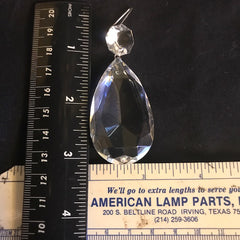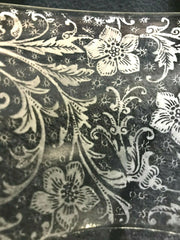Light Conversation — Chandelier Parts
How to Measure and Match a Crystal Piece for Replacement on Your Chandelier 0
Are you trying to measure or match your crystal pieces for replacement on your light fixture? We can help!
Measurement:
Ideally you want to get that measurement correct the first time as most folks, including us, charge restocking fees on returns of parts or they don't accept returns at all.
Replacement crystals frequently are sold with an attached octagon or button and a hook. Keep in mind that this top piece is not included in most measurements. In other words, a 2.5" almond is just that... 2.5" of almond shaped crystal with the added bonus of a top piece.
Below is a 2" measured.

We try to include the overall length (in this case 3.5"), but this height includes the pinning which can make the overall height vary a bit.
When trying to match crystals, it is more important to compare the height than the width. An off width will blend with different crystals better in most cases.
Details:
It can be quite difficult to verify that top "button" and the pinning on the piece you are wanting to purchase is the same as the piece that you need to match. If you are examining our parts, feel free to send specific questions. In most cases, we are happy to change the pinning or top piece for a small fee.
Quality:
Quality is very difficult to determine by photo. Generally, if you tell us the chandelier is pre-1980's, we can assume that the crystal are Italian quality, Czech quality, or Swarovski Strass. What does this mean?
Older Strass is unmistakable. It is thick, heavy and blindingly refractive. Newer Strass is a lighter due to the lack of lead oxide, but it is still gorgeous. (It is also thinner and etched with a trademark.)
"Italian Quality" usually means leaded crystal without great clarity. It is heavy, but whitish looking. Frequently the edges are duller and more molded looking as opposed to cut.
Czech Quality means the good, old stuff! It is a heavy, clear crystal, but not brilliantly sparkly like Strass. Sadly, this is being replaced by a newer, lighter crystal. Good for the environment (no lead) but sad for us traditionalists. Czech quality has edges that look more polished instead of molded.
Hope this is helpful.
- King's Chandelier Company
- Tags: Chandelier Parts How do I... Maintenance Restoration Files
Antique Glass Shades on the Website! 0
Summer is over, but our summer intern, Somer (you have to smile at that) has continued her project of pulling beautiful things from our treasure chests of old boxes -something we've talked about doing for, well, decades. Thanks to her hard work and meticulous photography, we have made a good start of putting these treasures on the website.
 Most of the lovelies that Somer has cataloged for us are these beautiful glass shades. Some of them date back to the 1860's we are sure, but any particular information about them has been lost over the years as we have lost the good folks that worked with them. Even if you don't need one of these shades, you will be impressed by the beauty and variety of our collection.
Most of the lovelies that Somer has cataloged for us are these beautiful glass shades. Some of them date back to the 1860's we are sure, but any particular information about them has been lost over the years as we have lost the good folks that worked with them. Even if you don't need one of these shades, you will be impressed by the beauty and variety of our collection.
As with all of our antique and vintage pieces, we've done our best to describe the condition of the particular piece, but we welcome all of your inquiries and requests for more photos.








- King's Chandelier Company
- Tags: Chandelier Parts Our Favorite Things Restoration Files
Candle Covers for European Chandelier Sockets 0
We have been having quite a few emails in response to our blog about candle covers, and most of these inquiries are asking about covers for European, E14, chandelier sockets (sometimes called International E14).

This photo does a good job of showing the diameter - both inside and outside. Also, you can see how thick the plastic is. This is a very thick, white matte plastic.
These covers are cut to order and we have added them to our site! As always, if you have any questions, email or call us.
- King's Chandelier Company
- Tags: Chandelier Parts Maintenance
How to Measure Chandelier Arms 0
It is very distressing to find yourself in need of a chandelier arm. Because they are all hand-blown, matches are difficult. A variation of less than half an inch is size can throw off the height enough to be extremely noticeable. So, size matching is more important than anything.
So, how do you communicate the details of a chandelier arm? Start with the measurement.
An "s" arm, also called a lower arm, is measured straight across. Most arms will come near to a whole-inch increment, and it will be referred to as such. For example, the below "s" arm is a 16" arm.

Although this would officially be called a 16" arm, it may not be exactly 16" across. So, for matching purposes, one would need to know the exact width.
The height of an "s" arm is from the lowest part of the bend to the highest part of the bend as shown above. Truly, in order to match a chandelier arm, it is best to compare, side by side, the old and the new. A side by side comparison allows us to observe the difference in bends, patterns and thickness.
When measuring an upper arm, measure straight out. When referencing the height, mention whether the measurement includes the ferule (metal cap).

Again, the bends on these vary quite a bit (along with the pattern) so it is always best to make an actual comparison.
If you are looking to match an arm, click here.
Other factors that should be considered when looking for a chandelier match: thickness (diameter - usually measured in millimeters), pattern, finish color.
Let us know if we can help! crystal@chandelier.com
- King's Chandelier Company
- Tags: Chandelier Parts How do I...
How to Add Crystal Accents to Your Chandelier 0
How to Add Crystal Accents to Your Chandelier
If you just want to dress your chandelier up a bit, there are many ways to do it. Here's a few ideas:
1. Add crystal rings, with a prisms or pendalogue hanging from it, to the arms. For this to be simple, ideally the ring needs to fit over the candle and slide down into the bend of the arm. If it won't fit over the candle, then you will need to add it from the back side of the arm. You can learn how to take the bottom of your chandelier in order to reach the arms here.


You can then drape crystal strands from pendant to pendant if you like. Shown here is our Winter Elegance.

Purchase rings here.
2. Use thin wire that can be purchased in the jewelry making section of Wal-Mart or Michael's. Wrap this wire around the chandelier arm or other piece. Cut a short piece of wire, then twist the ends into a spiral. Clip off the excess wire. Hook a prism or pendalogue into the wire. This is the simplest, least expensive way to add a bit of fun to your chandelier.

3. Using the cute little hand-held, hole punch below, you can punch small holes in stampings and other thin metals. Then, slip your pin through the hole.

4. Magnets are amazing! And we have some on clearance... Grab a magnet from your fridge and test you chandelier to make sure it will stick. These magnets are strong enough to hold just about any prism.

Have fun adding to your chandelier or sconce.
- King's Chandelier Company
- Tags: Chandelier Parts How do I... Room Ideas
To Shade or Not to Shade 0
Should you put clip-on shades on your chandelier or sconce?
There are many things to consider when deciding whether to add fabric shades to your fixtures. I am addressing crystal fixtures specifically, but many of the same ideas can be applied to other types of lighting.
One of the greatest things about adding shades to crystal chandeliers is that it softens the light. And, if the shades have white linings, the bulbs will reflect off that fabric and back into all the crystals. It really is quite stunning.
You can see in the photos above how the chandelier itself is lit by the way the shades push the light from the bulbs down onto the chandelier arms and prisms.
A few things to be aware of when purchasing:
1. Make sure that you are using a low wattage bulb - if using incandescent, between 15w and 40w, depending upon how big the shades are. If the bulbs become too hot, they will discolor the shades, or even worse, they will cause a fire. Most LED bulbs don't get hot enough to be of concern.
2. Clip on shades will fit either a candelabra bulb or a regular A15 or A19 (household type). Double check that you are purchasing the right type of shade.
3. Look at the interior color of the shade. We really like white interior for maximum brightness.
4. Most lighting fixtures will look best with a shade that has a bottom diameter of 4" to 6", depending upon how large the fixture is. Most of what we sell in the showroom is 4" to 5" bottom diameter.
5. If purchasing shades for sconces, ensure that the bottom of the shade isn't too wide. Measure the distance from the wall to the center of the socket. Half the diameter of your shade should be smaller than the distance from the wall to the center of the socket.
If you think that the light from wall sconces is a bit excessive, shades, either traditional or contemporary styles, are a beautiful way to soften that light.
From a decorating point of view, shades can be a way to change design perspectives of a fixture. An elegant drum shade can make a traditional chandelier seem more modern, or a bell shade can make a straight line chandelier seem more classic. In many cases, a shade can make a fancy chandelier just a bit less so.
Whether for practical reasons or aesthetic reasons, clip on shades can change the look of your lighting fixture.
A couple of our favorite shade sellers:Jubilee
WN Desherbinin
- King's Chandelier Company
- Tags: Chandelier Parts Choosing a Chandelier Room Ideas Room Photos







